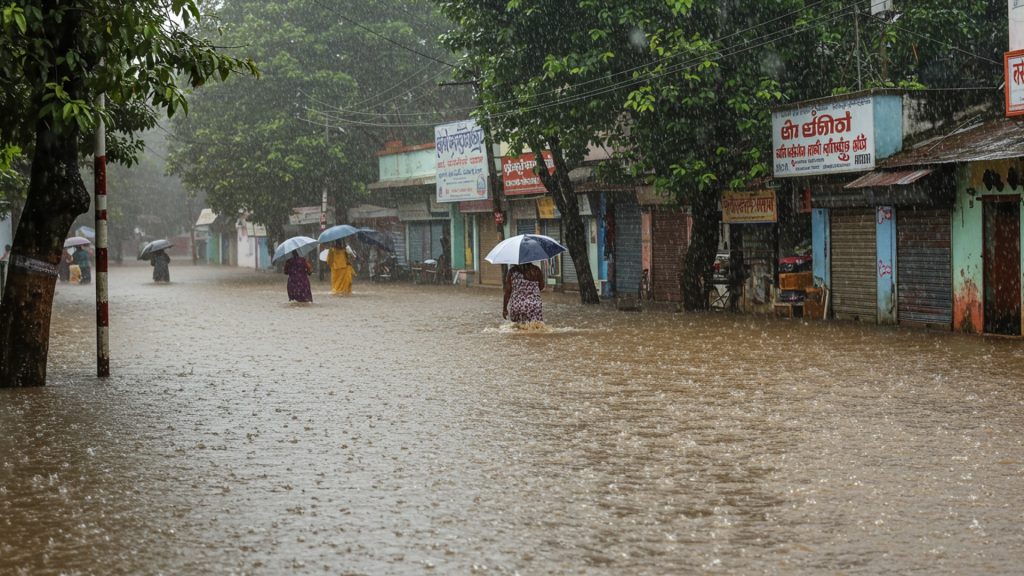Telangana is on high alert as the India Meteorological Department (IMD) has issued a red alert, warning of extremely heavy rainfall across the state starting immediately. This serious warning means many areas could face floods and significant disruption over the coming days. Authorities are quickly preparing for the severe weather, urging everyone to take precautions and stay safe as the region braces for the intense downpour.
Rainfall Warnings and Affected Areas
The India Meteorological Department (IMD) has issued a red alert for several districts in Telangana, forecasting very heavy to extremely heavy rainfall until August 20. This alert, specifically from 8:30 AM on August 18 to 8:30 AM on August 19, warns of rainfall that could exceed 20 centimeters in 24 hours in isolated areas. The districts of Mulugu, Bhadradri Kothagudem. Mahabubabad are expected to receive the most intense rainfall.
Beyond these red alert districts, a forecast of heavy to very heavy rainfall, measuring between 15 and 20 centimeters, has been made for Kamareddy, Komaram Bheem Asifabad, Mancherial, Medak. Sangareddy districts. The IMD has also warned of moderate to heavy rainfall for the remaining districts across Telangana. Thunderstorms with lightning and strong winds, moving at speeds of 30 to 40 kilometers per hour, are also predicted for isolated places across all districts until August 22.
Hyderabad, the state capital, is expected to experience moderate to heavy rain or thunderstorms, with intense spells at times, accompanied by gusty winds. This weather pattern is likely to continue in the city until August 20.
Government Takes Action
In response to the severe weather forecast, Chief Minister A. Revanth Reddy has instructed government officials to remain on high alert. A key step taken is the cancellation of all government employees’ leaves for the next three days to ensure full staff availability for emergency operations. The Chief Minister held a video conference with all district collectors from the Integrated Command Control Centre, discussing the flood situation and preparedness.
Officials have been directed to deploy National Disaster Response Force (NDRF) and State Disaster Response Force (SDRF) teams in advance to areas likely to be most affected. Instructions have also been given to move families from low-lying areas to safer relief camps to prevent loss of life. The Irrigation Department has been tasked with closely watching water levels in reservoirs, canals. rivulets. keeping district collectors informed about any water releases. As a preventive measure, officials are to keep sandbags ready to address any breaches or damage to reservoirs and ponds that are filling up rapidly.
Moreover, senior Indian Administrative Service (IAS) officers have been appointed as special officers in various districts to help coordinate relief efforts. The power department has been told to ensure mobile transformers are ready for quick power restoration and to continuously monitor low-lying areas. The Chief Minister also advised the data & Public Relations Department to monitor the spread of false news and to provide regular, accurate updates to the public.
To support immediate relief operations, the state government has released one crore rupees to each district affected by the heavy rains. This fund is meant for instant relief and to buy necessary equipment to handle flood-like conditions, such as air boats, life jackets, sophisticated sirens, ropes, ladders, bush cutters, gas cutters. mike sets. The Revenue Minister, Ponguleti Srinivasa Reddy, emphasized that these funds are for relief measures and that senior officers will oversee their use.
Impact on Life and Property
The heavy rainfall that began on Sunday, August 17, has already caused significant disruption across the state. Reports indicate the displacement of people, widespread flooding of crops over thousands of acres. severe damage to infrastructure, particularly roads and low-lying culverts. This has cut off road access to several villages, including some stretches between Telangana and Maharashtra in Adilabad district.
Districts like Mulugu, Adilabad. Mancherial have recorded very high rainfall in short periods. Govindaraopet in Mulugu district saw 22 centimeters of rain, Tamsi in Adilabad district recorded 17 centimeters. Mancherial received 12. 5 centimeters in just an hour and a half. These heavy downpours have led to waterlogging on roads, flooding in low-lying areas. substantial damage to cotton and paddy fields. Saplings have been washed away. many roads, bridges. canals have suffered damage. In some areas, traffic came to a complete halt due to overflowing streams and rivers, forcing motorists to find alternative routes.
Past incidents have also shown the vulnerability of the region. Cities in Telangana were originally designed to manage about 2 centimeters of rainfall over 24 hours. But, the recent trend of climate change has resulted in 30 to 40 centimeters of rain falling in just two hours, which the current drainage and road systems are not equipped to handle.
Preparing for the Worst
Officials are focused on preventing any loss of life and livestock. The Chief Minister has stressed the importance of having helicopters ready for emergency airlifts during floods, in coordination with agencies like the Indian Army and NDRF. The health department has been directed to ensure that medicines and doctors are available for emergencies and to carry out sanitation drives in waterlogged areas to prevent the spread of water-borne diseases.
Police officials have been instructed to stop people from going near fast-flowing water and to manage traffic, especially in high-risk areas. They are also tasked with preventing movement on low-level bridges and causeways where water levels are rising dangerously. The government has asked IT companies to consider allowing employees to work from home and the education department to decide on school closures, depending on the severity of the situation.
To improve long-term flood management, the Telangana government has announced the formation of a specialized Telangana Disaster Response Force. This unit aims to handle emergency situations, including floods, more effectively. Engineers and irrigation experts have also suggested a plan to connect 185 tanks in Hyderabad using modern technology. This initiative aims to redirect floodwaters and prevent flooding in low-lying areas, which would make the city more resilient to heavy rainfall.
Public Safety and Assistance
The Greater Hyderabad Municipal Corporation (GHMC) authorities have issued a high alert for Hyderabad and have set up control rooms to manage emergency services effectively. Residents are advised to stay alert and avoid going out, especially in areas prone to flooding. For emergency help, people can contact various toll-free numbers: NDRF- 8333068536, 9154170992, 8712660600, 040-278524482. the general emergency number 100. Public warnings about potential flooding, fast-flowing rivers. unsafe bridges will be shared through FM radio and other communication channels. Citizens are urged to leave their homes only when necessary.
The state government has emphasized that traffic management is a key focus, especially in Hyderabad and district headquarters, to avoid congestion during peak rainfall hours. Measures are also in place to address the safety of railway lines and to ensure drinking water is not contaminated.

